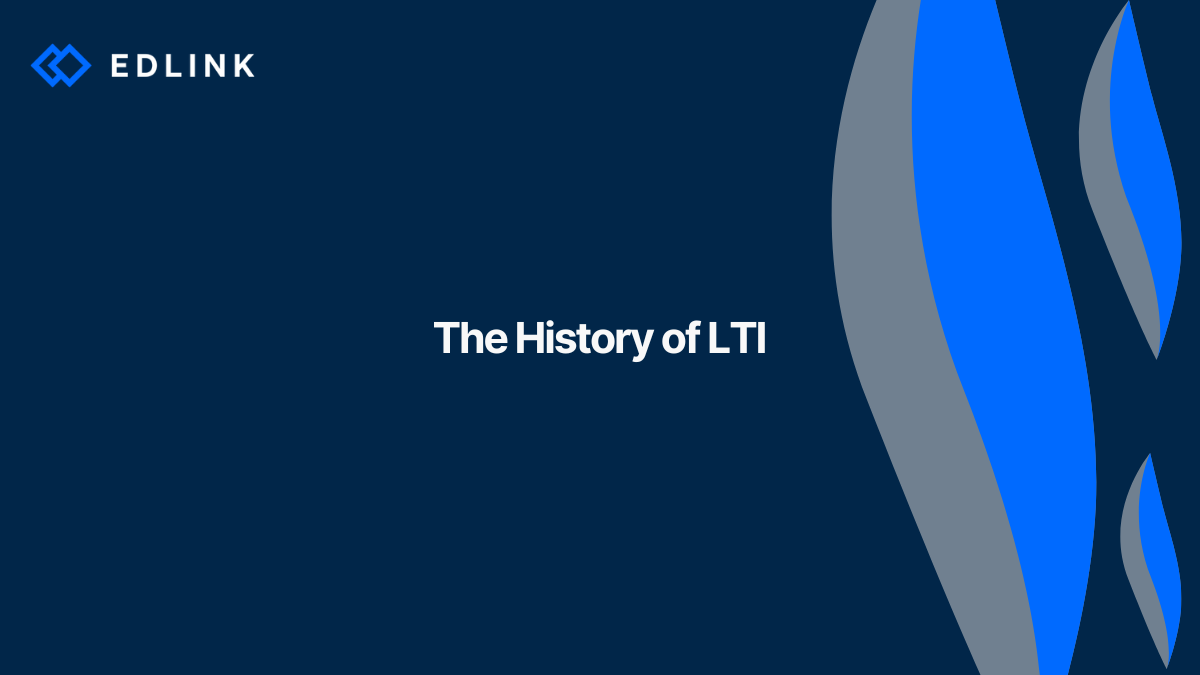The LTI specification provides a framework for external tools and content providers to integrate with LMS providers. Since created over a decade ago, this “framework” has gone through a few different reorganizations throughout the years - much like the development of consumer tech products. These reorganizations are a note to realize LTI integrations, though helpful at times, ultimately will need to be redone over and over again to remain “updated” on the latest version.
Below is a timeline of LTI to date, starting with LTI’s initial versioning, LTI 1.0.
LTI 1.0
LTI 1.0 launched in 2010 with the goal of creating a specification for integrating external learning tools into an LMS. With the variety of LMS providers used by K12 schools/districts and higher ed universities, LTI aimed to give learning tool publishers a way to easily integrate with whichever LMS the learning institution used. LMS providers supported the concept of integrating across different platforms. An LMS that supported a way to easily integrate with a growing ecosystem of external learning tools could increase the value of that LMS to learning institutions. Educators could now adopt curriculum content that integrated with their LMS, regardless of the platform they used.
The first iteration of LTI gave LMS users a way to launch into an external tool via the user’s LMS. An educator could post a link containing specific parameters to a course in their LMS. A student was then able to click on this launch link, which sent the external tool provider the parameters and digitally signed the payload using OAuth 1.0. Once the LMS posted the message to the tool provider, the provider would respond by displaying the tool in the user's web browser.
LTI 1.0 focuses on launching users into external tools. Tools that work well with this framework are online textbooks. LTI could easily authenticate students and the parameters passed to the tool provider, letting the “provider” (read: LMS) know what chapters or resources should the student be directed toward. However, as learning tools become more complex, so does the need for more advanced integrations.
LTI 1.1
In LTI 1.0, the connection between the consumer (student or educator) and the tool is severed after the initial connection is made. This made actions that require communication between the tool and the LMS, such as grade passback, impossible. LTI 1.1 sought to remedy this by providing a means to pass additional information between an LMS and a tool.
LTI 1.1, introduced in 2012, uses the same launching procedure as LTI 1.0. The difference is that extra parameters are passed when the user launches into the LMS. These extra parameters direct the tool to a location to which an outcome (or grade) can be placed and a ticket that ensures the outcome is properly labeled for the specific user and course. This entire process is asynchronous. The simplicity of the LTI 1.1 framework led to widespread adoption of the specification.
LTI 1.2 & 2.0
As the complexity of external learning tools grew, so did the need for enhanced services and deeper integrations with learning platforms. LTI 1.2 and 2.0 were developed and released in tandem in 2014 to improve interoperability. LTI 1.2 was seen as a stepping stone of the LTI 1.x framework that publishers could adopt before they could fully upgrade to LTI 2.0.
LTI 2.0 introduces REST web services as a way of implementing bi-directional services. The method of launching LTI tools remained the same but would now allow for discoverable services, architected services, and partner-provided services. However, the LTI 2.0 framework was built around OAuth 1.0, which has since been deprecated. Furthermore, anyone wishing to receive certification for LTI 2.0 had to certify for all services that LTI 2.0 supported, which the publisher of the tool may not have even need to use. Due to increasing concerns about student privacy and the complexity of implementing the framework, LTI 2.0 saw very low levels of adoption across the industry.
LTI 1.3 & LTI Advantage
Due to a lack of widespread adoption and increasing security concerns, 1Edtech decided to deprecate the LTI 2.0 (and 1.2) framework. Instead, a new model would be built on the popular LTI 1.1 specification, which would take advantage of industry advancements in security and decrease complexity for external tool developers. This new core version is called LTI 1.3 with services packaged as LTI Advantage.
A simpler way to understand that is to say: LTI 1.3 has one core functionality. But if a tool wanted additional functionality (referred to as services by 1EdTech), then the tool's developer could “add on” more “services” (from LTI Advantage) to their LTI 1.3 build.
LTI 1.3 is a framework that adopts modern security OAuth 2.0 and JSON Web Tokens (JWT). LTI 1.3 also adopts the OpenID Connect (OIDC) specifications. Services, such as the Outcomes and Membership services in LTI 1.1, are now decoupled from the core LTI framework. This allows updates to be made to the core LTI 1.3 specification without needing to update the entire suite of LTI services, thus making the process of updating and re-certifying LTI 1.3 compliant tools much simpler.
LTI Advantage is a set of services that are to be used on top of the LTI 1.3 security model. These services are called Names and Roles Provisioning (formerly Memberships in LTI 1.1), Assignment and Grade Services (formerly Outcomes), and Deep Linking. LTI Advantage is designed to allow adopters of the LTI 1.3 specification to implement all or only some of the services, depending on their needs. LTI 1.3 certification is a prerequisite for LTI Advantage certification.
LTI Today
As of May 2019, 1EdTech has officially deprecated all versions of LTI since the release of 1.3 and Advantage. The current recommended upgrade path for publishers is to build on the LTI 1.1 model and develop applications using the core LTI 1.3 framework, intended to enhance user and data privacy. LTI Advantage is now the specification whereby current services are updated and new services will be added.
*Updated: 11.30.23
Learn More about LMS Integrations
If you’re interested to learn more about LMS Integrations here’re other articles we’ve written:
- Building or Buying Your LMS Integrations
- The Benefits of Integrating Your App with an App
- Updated | State of the LMS Market
- Single Sign-On in Edtech: 6 Reasons Why You Need To Give Schools Multiple Options for SSO
Want to Learn More about Edlink?
If you're looking for a partner who can help guide you through developing LMS integrations (like these), then let’s introduce ourselves. We’re Edlink!

